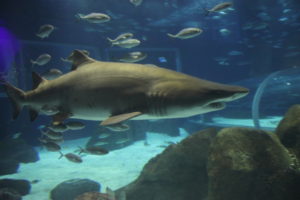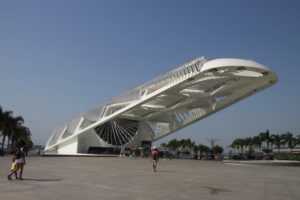I visited Brazil’s best-known city, Rio de Janeiro, a couple of times in the 1970s and, finally, this fall (2019) had the chance to revisit. The run-up to this visit was not especially auspicious.
Earth’s lungs — the Amazonian forests — were (and are) aflame. The seemingly unconcerned Brazilian president, Jair Bolsonaro, last summer resisted international pressure to curtail the mostly manmade fires while saying, “ … the Amazon is Brazil’s, not yours.”
However, on the ground in Rio this September, I encountered serious concern about the environment, made manifest in part at a couple of the city’s newest tourist attractions.
I refer to AquaRio, an aquarium, and the futuristic Museum of Tomorrow, both of which predate Bolsonaro, BTW.
In anticipation of the 2016 Olympic Games, which Rio hosted, the two attractions were created as part of a larger project to rejuvenate the city’s port district with renovations, restorations and creation of all-new facilities.
In fact, AquaRio, although meant for rollout before the Games, didn’t quite make it — it opened in late 2016 but performs its roles well as an enhancement to the port district and an educational facility for the kid in all of us.
It is located in a repurposed meat market that now has a solar power plant on the roof; the plant provides 20% to 30% of the facility’s power needs.
AquaRio’s centerpiece is an acrylic tunnel that extends 66 feet through a 925,000-gallon tank, with sharks and stingrays swimming by.

The 66-foot acrylic tunnel that visitors walk through for up-close views of sharks, stingrays and other marine life.
Families with youngsters 6 or older can overnight in the tunnel on Fridays. Other visitor experiences include swimming with sharks, or feeling sharks and rays in a touch tank.
Smartphone users can get more information about exhibits by accessing QR codes found amidst the other 27 tanks; info is in English as well as Portuguese.
Also, of interest, visitors of all sizes (and ages) are invited to look through any of a series of windows, designed to look like snorkel gear, to see the kinds of things one should NOT drop into the oceans.
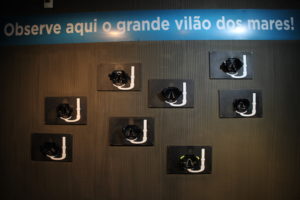
For lessons in what is bad for the oceans, this wall, outfitted with windows designed to look like snorkel gear, invites visitors of varying heights to peer into a roomful of junk of the type humans shouldn’t, but do, toss into the water.
During my visit, several groups of boisterous half-grown children were on site for what were apparently class outings.
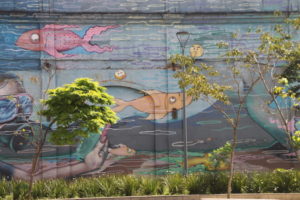
Outdoor wall mural, featuring marine life, located just across a street from one of AquaRio’s entries.
A serious look ahead
But, Rio’s piece de resistance is the Museum of Tomorrow, a high-tech facility that invites visitors to explore the various futures humans could create in this century.
The facility, which is not overly large, is set up in sections designed to provide an overview of Earth’s origins followed by a look at life on Earth as influenced by humankind, including the future.
But first, there is the overhead globe in the entry atrium. Its appearance keeps changing because, with links to constantly updating databases, it shows in real time where hurricanes were active, actions of the ocean currents, carbon dioxide in the atmosphere and more.
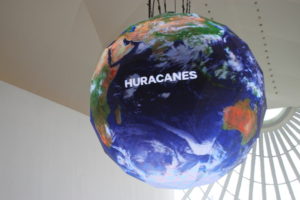
Overhead globe in the Museum of Tomorrow. Designed to illustrate data on weather and atmospheric conditions, the above version illustrates where hurricanes were active on the day the photo was taken.
Then, the timeline starts at Cosmos, a theater with an enveloping overhead film about Earth’s geology and evolution, viewed while lying down. The pillows were comfortable — one of my fellow viewers had to wake his baby as the credits ran.
The centerpiece is devoted to the Anthropocene, or the Age of Man, and this picture was not nearly as relaxing!!
Here visitors stand (or sit, in my case) surrounded by 32-foot-high video screens that constantly update stats on the various ways humankind has changed and/or destroyed some parts of our planetary home. Its very sobering displays show things like our energy and water usage; meat consumption; population figures of recent decades, and stark images of ruined landscapes and smoke-blackened skies.

Centerpiece of the Museum of Tomorrow, a circle of video screens trumpeting, via constantly rotating displays, details of the Anthropocene (Age of Man) and man’s effects on Earth.
Right. This is the Age of Man.
From here, shaken visitors may head to the Tomorrows exhibit, where they can, at interactive stations, ferret out the different possibilities for the future of life on Earth and “plan” a future based on the life choices they select on the screens in front of them. After which, Us is the last stop (see photo).

The room called Us, where visitors walk among lights and sounds that interact with their movements, showing that with our every action, we affect the world around us. The wooden structure itself is based on an indigenous house of knowledge where communities share stories.
The interactive stations and electronic displays throughout the museum rely on IRIS cards, artificial intelligence and databases that update information screens (in English, Portuguese and Spanish) in real time. It’s a tour de force.
Further, the building, on a Guanabara Bay pier, looks like a white ship about to fly into the future (see photo, above). Its rooftop solar panels, helping to power the building, move to follow the sun.

The overhang at the back of the spaceship-like Museum of Tomorrow. The facility is sited on Guanabara Bay. The corralled water in the foreground is part of the museum’s cooling system and is used for reflecting pools.
A last thought on the museum
The Museum of Tomorrow is an impressive piece of work just to look at, inside and out. But, at its core are educational materials that, I think, should be accessible to the general public beyond this museum, given most people cannot easily get to Rio.
So here are other options, spelled out by Claudia Lamego, a communications officer for the museum:
- Some traditional museums are using similar technology to deliver information, she said, such as NEMO Science Museum in Amsterdam and the Science Museum Group of museums in the U.K.
- Museums that resemble Rio’s Museum of Tomorrow, she added, include Berlin’s Futurium and Dubai’s Museum of the Future, the latter to open this year.
- The Rio facility has inspired creation of the new (from October 2019) FORMS (Futures Oriented Museum Synergies), an international community of future-oriented museums. The organization wishes to foster best museum practices that inspire action for sustainable futures.
Air travel as polluter
And, one other thing about this trip: My air reservation, booked by a Rio-based travel agent, included a piece of information I had not seen previously on a confirmation.
The reservation included a calculation of the carbon emissions associated with my New York-Miami-Rio de Janeiro roundtrip. The document also referred me to the following Web site, where anyone can calculate the carbon emissions attributable to any air trip: https://www.icao.int/environmental-protection/CarbonOffset/Pages/default.aspx
The URL belongs to the International Civil Aviation Organization (ICAO), the UN body overseeing global aviation.
The ICAO has spearheaded an effort to significantly reduce the air industry’s carbon emissions. Seventy nations, including the U.S., are participating in this awkwardly but carefully named project, the Carbon Offsetting and Reduction Scheme for International Aviation (CORSIA). Implementation started this year with the carriers measuring and reporting emissions.
But, the ICAO had previously developed the methodology to calculate carbon dioxide emissions associated with specific trips — the first version appeared in 2008. Now, the current version of this fuel formula, while available to you and me at the above URL, is used when making calculations for the CORSIA offsetting requirements.
More info than you needed, maybe, but try it!
For more information about Rio de Janeiro, we offer at BestTripChoices.com the following, under the headline, Where samba and soccer meet: https://besttripchoices.com/international-cities/rio-de-janeiro-brazil/
This blog and its photos are by Nadine Godwin, BestTripChoices.com editorial director and contributor to the trade newspaper, Travel Weekly. She also is the author of “Travia: The Ultimate Book of Travel Trivia.”


